Editor's note: This post was originally written by Klaviyo’s Alicia Thomas. It has since been updated for relevance and accuracy.
The Black Friday Cyber Monday (BFCM) weekend is without a doubt prime time for ecommerce businesses.
In 2022, online consumers in the US spent a record $9.12 billion on Black Friday. Shopify merchants alone saw a combined $7.5 billion in sales worldwide over the 2022 BFCM weekend, a 19% increase from the year prior.
How do you win a piece of the Black Friday revenue pie? With over half of consumers preferring to hear from brands over email—significantly more than over social media, text, or phone—email marketing is the right route to take.
But email inboxes are packed during this time of year, so you have to be clever about it. The more relevant you can be in your emails and the less inbox clutter you create, the better. Personalized emails are the way to go, and nailing your segments will help you make the most of your email strategy.
Dive in to learn why Black Friday consumer segmentation is worth it, along with 13 segments you can implement in your BFCM marketing strategy.
Table of contents:
- What is Black Friday consumer segmentation?
- 1. Seasonal shoppers
- 2. Recent email openers and engaged subscribers
- 3. VIP customers
- 4. Product browsers
- 5. Category buyers
- 6. Engaged non-buyers
- 7. Recent purchasers
- 8. Email ignorers
- 9. Almost purchasers
- 10. Geographic targets
- 11. Low-value customers
- 12. Gender-based segments
- 13. Cart abandoners
- Bonus tips for successful BFCM consumer segmentation
What is Black Friday consumer segmentation?
Black Friday consumer segmentation is a marketing strategy that customizes promotional emails during the BFCM period based on the recipients’ purchases, engagement levels, loyalty status, or demographics.
Your audience’s inboxes are already overflowing with “20% off everything this Black Friday” emails. Sending those same, generic offers won’t help you stand out.
By segmenting your email list, you can hyper-customize each Black Friday email: reward your most loyal customers, nudge those on the fence to finally make a purchase, and feature the most relevant products based on previous browsing sessions or purchases.
This approach means you don’t need to rely on luck or fear that your competitors will outshadow you. You’ll deliver the right message and products to the right people at the right time—and turn your emails into profit.
Here are the 13 BFCM segments to consider this season:
1. Seasonal shoppers
With a seasonal shoppers segment, you can re-engage customers who bought from you during last year’s BFCM campaign or another holiday shopping event. That’s your chance to remind them of the deals they got last time around and prepare them for what’s coming this Black Friday.
You can even further segment this group of customers. For example:
- Top customers by revenue
- Customers that purchased at full price
- Repeat customers
- One-time holiday shoppers
- Coupon code users
- Different spend ranges
- Product category
This way, you can nail your messaging to match the expectations they have from a Black Friday sale. You can also segment those customers that returned the products they purchased during a holiday sale and either have dedicated emails for them or exclude them from your BFCM campaign.
2. Recent email openers and engaged subscribers
People who open your emails and click on the links inside them already know you and your products. They’re interested—and they have been for months or even years—so make sure you reward that.
You can offer early access to discounts, a greater discount compared to what’s available publicly on your website, or a free product with their order.
Pioneer, a brand of slim wallets, emailed its subscribers to announce an upcoming, subscriber-only Black Friday discount.
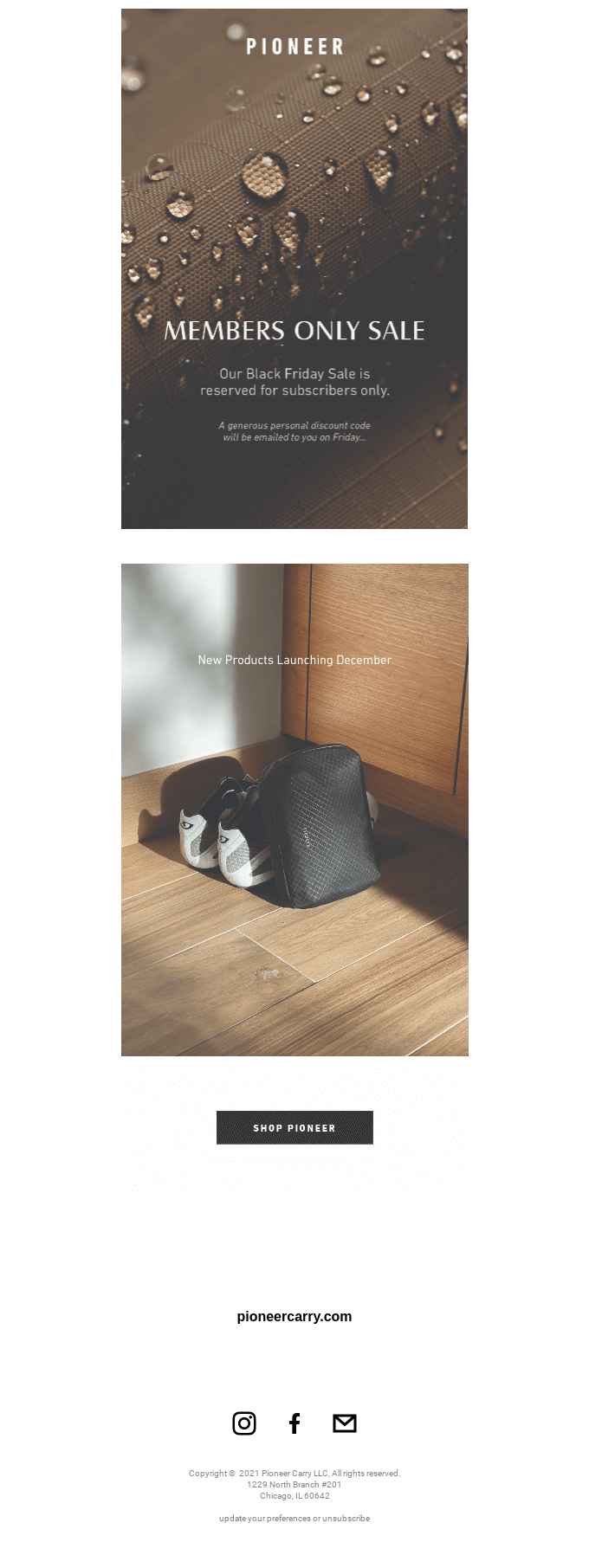
Pioneer’s Black Friday email announcing subscriber-only discounts. Source: Really Good Emails
3. VIP customers
VIP customers are your most valuable customer segment. What VIP means is specific to each business, but usually includes one or more of these factors:
- Regular purchases for years
- High spend
- High number of orders
- Plenty of referrals they sent your way
Whichever criteria applies to your VIPs, give them special treatment. Make them feel valued and show them how much you appreciate their business.
You can offer an extra discount, give them more time to shop your offers, provide early access to new products, waive their shipping fees, and more. Don’t hesitate to tell them they’re getting that special treatment because they are a VIP.
CityLocs, an ecommerce store that sells customized hats, t-shirts, and accessories, built a VIP customer segment for its Black Friday campaign that included customers who purchased more than three times, spent more than $500 in a single order, or were tagged as B2B customers.
Customized orders take two weeks from order rate to delivery, so CityLocs gives its VIPs access to special discounts three to four days before the BFCM weekend.
“This does three things,” says Tabish Bhimani, CEO of Mastrat Digital, the agency that runs these campaigns for CityLocs. “It gives preferential treatment to loyal or big customers, allows the production team to anticipate and plan for big orders, and reduces the ’Where’s my order?’ tickets.”

CityLocs’ early Black Friday email that goes to VIP customers
4. Product browsers
Your potential customers are browsing lots of online shopping sites to find the best deals—some of them dozens. Your chance to win them over lies in emailing those product browsers who haven’t made a purchase yet.
These emails are called browse abandonment emails, and they’re an excellent way to get back on your visitor’s radar. Your products and Black Friday offers can be the best out of everything they’ve seen, but they might get overwhelmed or distracted and miss out.
Gentle reminders paired with a Black Friday discount—just like the outdoor gear company Columbia did in this example—is the way to go.
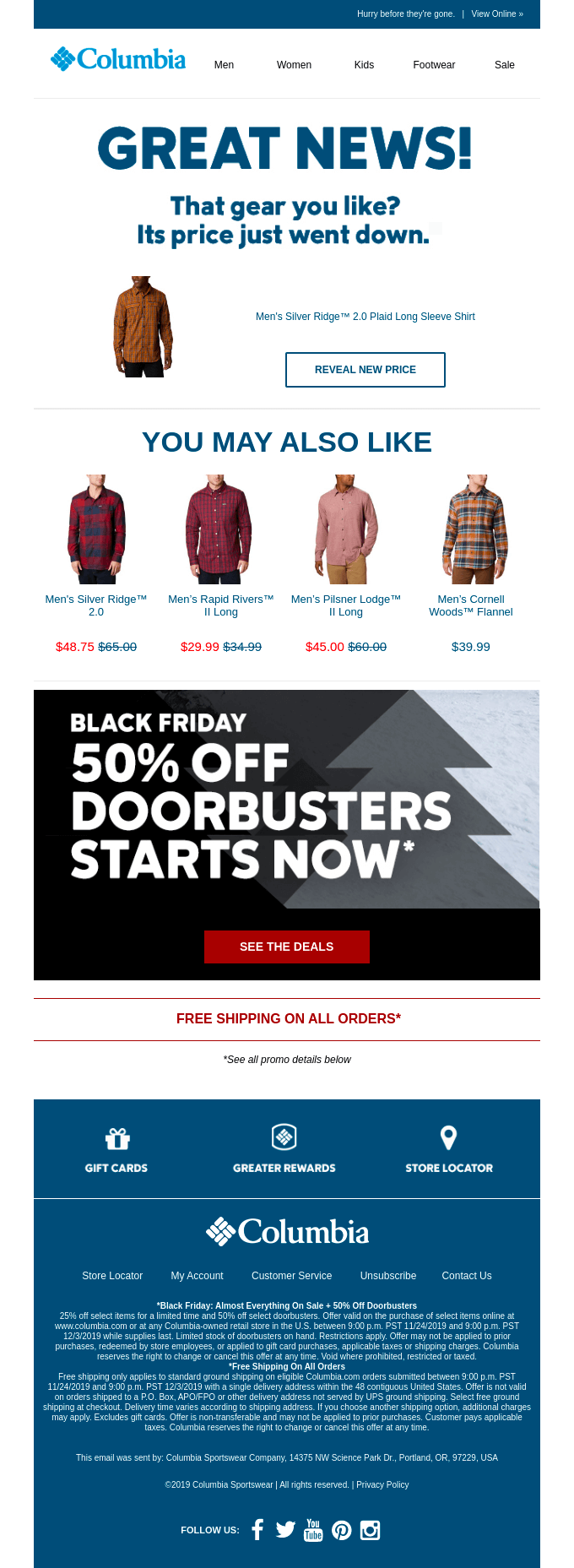
Columbia’s Black Friday email that focuses on bringing product browsers back to the site. Source: Really Good Emails
5. Category buyers
The category buyers segment is about your customers’ previous purchases, browsing journeys, and product preferences.
By targeting this segment in your Black Friday email campaigns, you can promote products related to the ones they’ve purchased, newest products from that category, or products complementary to the ones they already own.
For example, if someone previously bought a formal dress, you can promote the latest styles of shoes and bags that would go with it. If they bought a kitchen appliance, you might feature accessories or a cleaning kit for that appliance.
L’Occitane, a luxury cosmetics brand, personalized its Black Friday email based on the customer’s preferred product category and promoted an item they recently viewed or abandoned in their cart. Paired with scarcity at the top of the email that counted down the days until the end of the campaign, L’Occitane saw an 80% lift in click-through rate with this approach, Movable Ink reported.

L’Occitane’s Black Friday email that includes products from a relevant product category
6. Engaged non-buyers
This is a similar segment to recent email openers, with one key difference: it emphasizes the fact that this recipient hasn’t purchased yet, and that they’ll get rewarded for making that first purchase.
JustFab is one example of a brand that implements this. JustFab operates as a paid monthly membership that gives members credits they can redeem for products and bundles, as well as access to deals and exclusive benefits.
In this Black Friday campaign, JustFab offered a fixed $10 price for the first pair of shoes, along with a 50% discount site-wide, to those who become a new paid member.
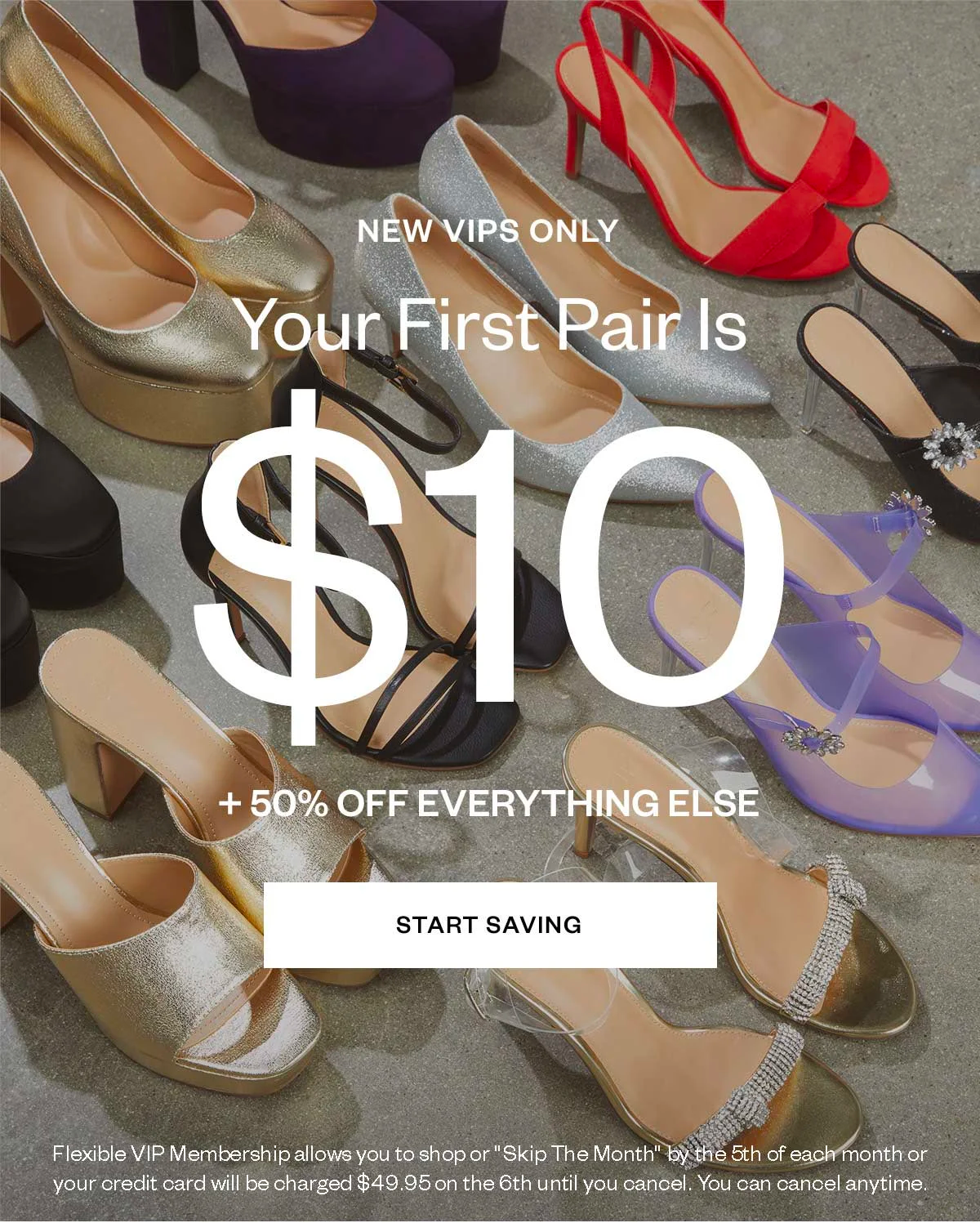
JustFab’s Black Friday offer for recipients who become a new paid member. Source: Milled
The Pro’s Closet, a company selling new and used bikes, offered a $20 credit for a first purchase over $100 with a custom discount code. Right below this call-to-action, it included a promotion of additional Black Friday deals, nudging those on the fence to become first-time customers.

The Pro’s Closet’s Black Friday promo for first-time customers. Source: Really Good Emails
7. Recent purchasers
There’s almost nothing that frustrates shoppers around holidays as much as a discounted product they’ve just paid full price for:
Discounting your products is fair game, but lean on segmentation to avoid this. After all, these people have shown you they trust in your product enough to pay its full price, giving you a larger profit margin and increasing your customer base despite the fact that BFCM was just around the corner.
The time frame for this segment depends on the typical purchase frequency for the products you sell. Fragranced candles might need a monthly refill, while a pack of laundry tablets could last for three to six months. Whatever frequency applies to you, exclude those customers that bought that product less than that many weeks or months ago.
8. Email ignorers
Sometimes you just can’t cut through the noise of Black Friday for one reason or another. It’s quite possible that among the dozens of emails a subscriber received, they skipped right over your holiday sale.
Due to the increase in Black Friday Cyber Monday emails, create a special segment just for those who ignored (didn’t open) your earlier emails. The three main ways to make this email successful are:
- Timing, i.e., send when things get less chaotic
- A click-worthy subject line
- An incentive like a discount or freebie
Scarcity is the way to go with email ignorers, so emphasize that this is truly the last chance to get BFCM benefits. That’s what Three Ships Beauty, a natural skin care company, did with this email that featured a minimalistic design and an emphasis on its buy one, get one free (BOGO) discounting strategy.
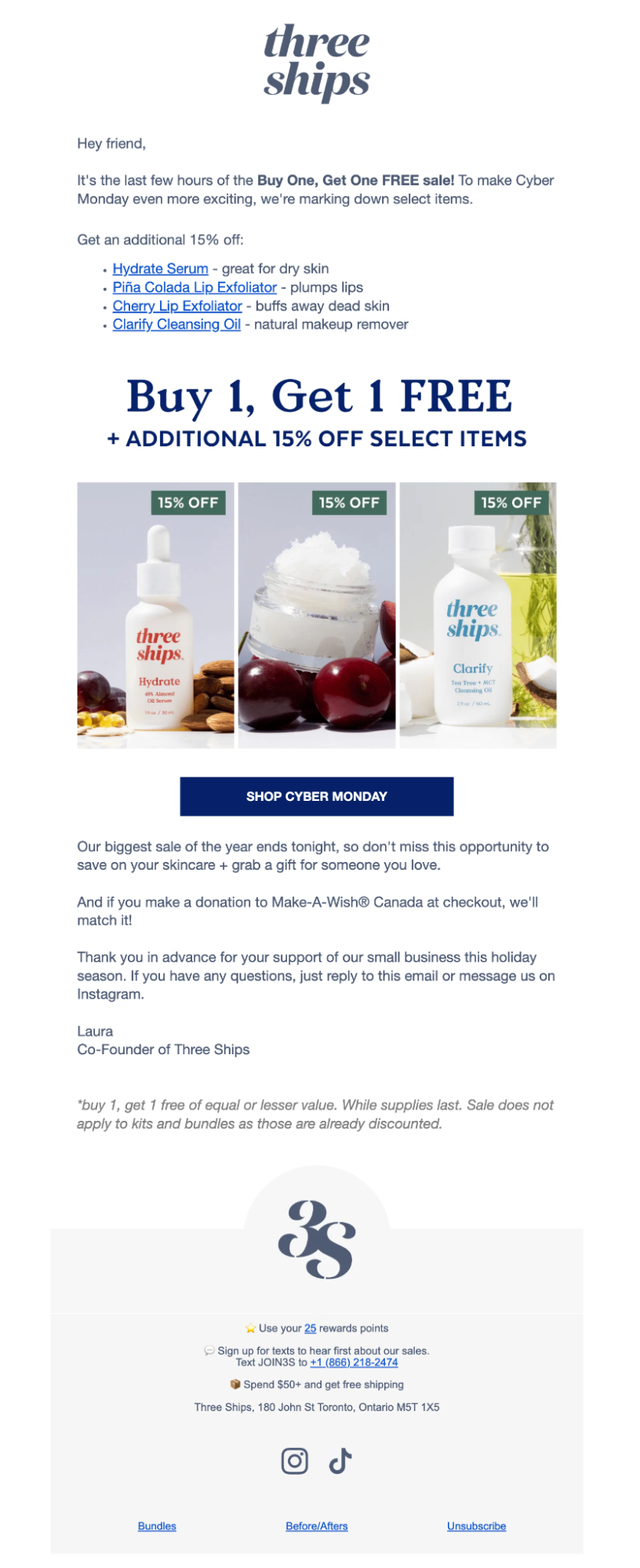
Three Ships Beauty’s Cyber Monday email that focuses on scarcity and buy one, get one free opportunity. Source: Milled
9. Almost purchasers
What about those email subscribers who have opened your BFCM emails, but haven’t made a purchase? They’re another segment you can define and re-engage.
Instead of sending everyone the same catch-all emails that promote your bestselling products and offer a generic discount, send your Black Friday email openers a follow-up that mention their previous email engagement.
You can use email copy to remind them of it, list the products they’ve viewed, or both. The goal is to make their journey personalized and relevant, so they can pick up right where they left off—even if it was earlier that day or the day before. It’s the key to breaking through the Black Friday shopping noise.
J.Crew, a fashion retailer, does a fantastic job with previous Black Friday email viewers in its re-engagement campaign.

J.Crew’s re-engagement Black Friday email. Source: Milled
10. Geographic targets
You can send BFCM emails that take into account the location of their recipients. Thanks to the shipping and billing details you collect at every sale, you already have access to a mountain of location data.
Some ways you can use location-based segments include:
- Shipping: Customize your messaging based on the length (“Order before X to receive your order in [state] on time”) or cost (“We ship for free to [state] when you spend more than $X”).
- Climate: Recommend different products based on weather and typical activities for that time of year.
- In-store offers: If you have physical stores, encourage customers near them to take advantage of offers limited to those locations.
DSW, a footwear brand, promoted its warm shoes to New York–based customers by including the weather forecast for that area.
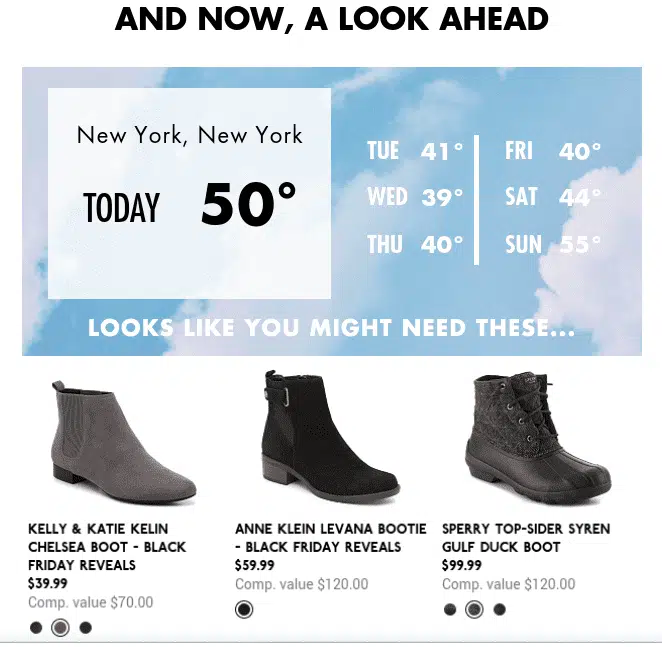
DSW’s weather-based Black Friday email promotion. Source: Sailthru
11. Low-value customers
In the segments so far, you’re rewarding loyalty, engagement, and interest. What about those subscribers and customers that haven’t been as active, or spent as much money on your products?
They may no longer be interested in your products for one reason or another. While it may sound harsh, the truth is that these customers are less valuable to your business
It wouldn’t be fair toward your high-value customers to offer them the same Black Friday benefits. Instead, you can focus on tactics that won’t significantly lower your profit margins, while still nudging them toward another purchase.
For example, you can offer a lower discount compared to your VIP customers, like 10% or 15% compared to 25% or more, or make it redeemable for a shorter time period, like 24 hours.
12. Gender-based segments
Gender-based segments are nothing revolutionary, but in a busy BCFM season of emails, they can make a tremendous difference.
If you sell products tailored to both men and women, this type of segmentation is table stakes—you’re at risk of spamming your subscribers otherwise.
But here’s where gender-based segmentation can make a significant difference. Kent Brushes, a brand of handmade hair brushes, promoted the same beard grooming products to male and female recipients, but with a different message.
Men got a “Get ready for The Kent 2020 Shave” message, while women received a “Give the gift of a perfect shave” message. Swanky, a Shopify Plus agency that ran this campaign, reported fantastic results: an 88.9% and 73.7% open rate for women and men, respectively, compared to 54.5% for recipients of a non-personalized message.
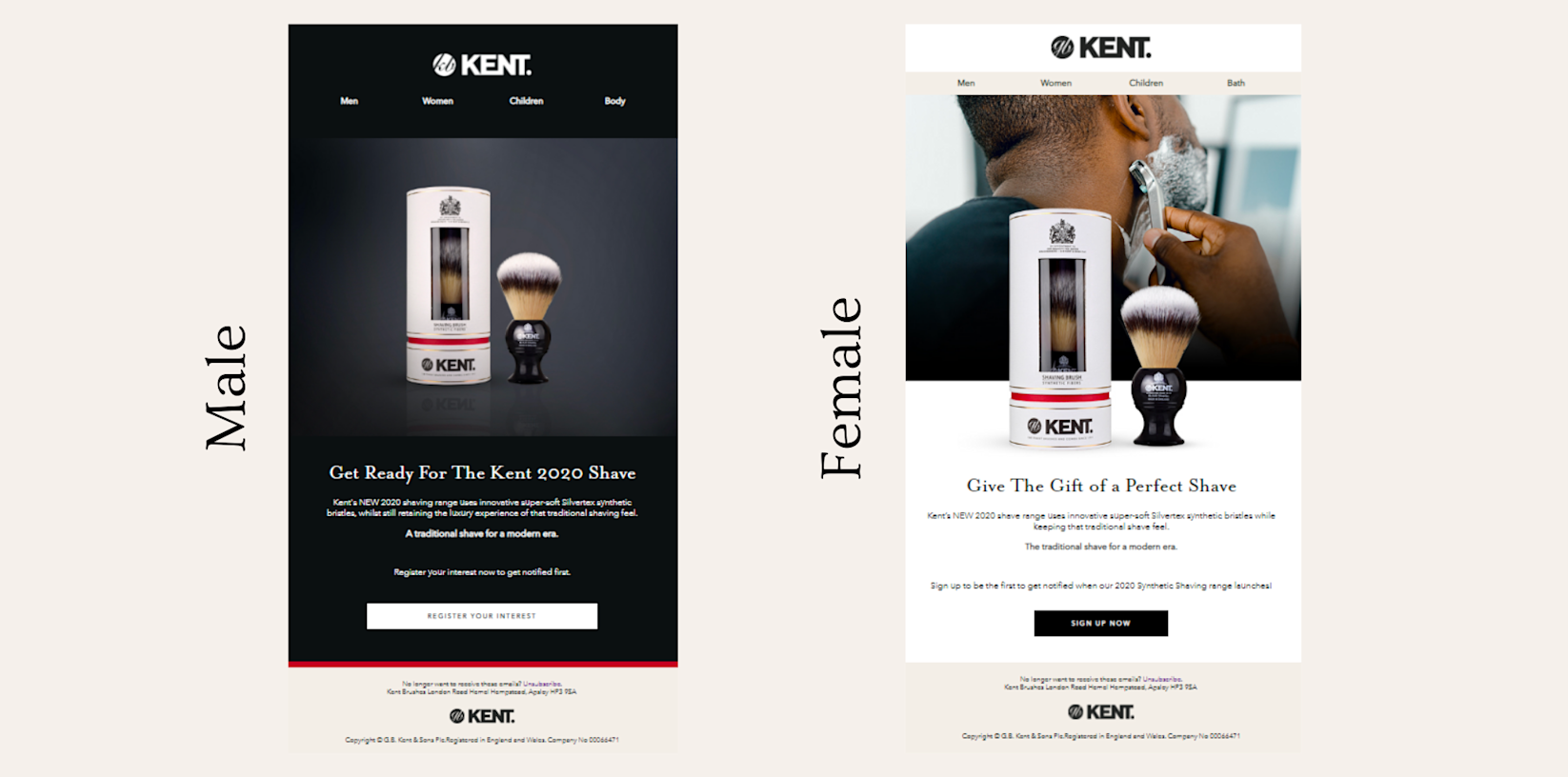
Two versions of a Black Friday email campaign by Kent Brushes, segmented by gender. Source: Swanky
13. Cart abandoners
Finally, don’t forget about one of the most powerful consumer segments in ecommerce: cart abandoners. During Black Friday promotions, cart abandonment rate tends to hover between 77% and 82%, which is higher than the average of around 70% year-round.
To make sure your cart abandoners don’t slip through the cracks, remind them of the products they left in their shopping cart.
This works whether you offer Black Friday discounts or not, as proven by Represent. The luxury streetwear brand kept its automated cart abandonment emails and drove an 8.3% purchase rate with them during Black Friday despite not offering any discounts on abandoned items.

Represent’s no-discount cart abandonment email for Black Friday. Source: Klaviyo
Bonus tips for successful BFCM consumer segmentation
Check out these two final tips to nail your Black Friday campaign efforts:
1. Segment out Black Friday purchasers
Use segmentation to make sure that customers who made a purchase on Cyber Weekend do not continue to receive further promotional emails. Transactional, informational, and onboarding emails about the items they just purchased are, of course, fine.
This is a good idea to improve deliverability—those who have already purchased probably won’t be opening more promo emails from you—and to maintain a good brand experience. How would you feel if you just made a purchase and you continued to get treated like the transaction never occurred?
2. Think about gift givers
Promoting your products as great gifts is an excellent way to engage less active customers or subscribers, as well as those that have selected a gift wrap option in one of their past orders.
The Black Friday Cyber Monday weekend is the time many people are on the hunt for holiday gifts, so you can take the approach of Modern Picnic, a brand of designer lunch bags, that primed its customers for gift shopping during BFCM weekend with a gift guide.
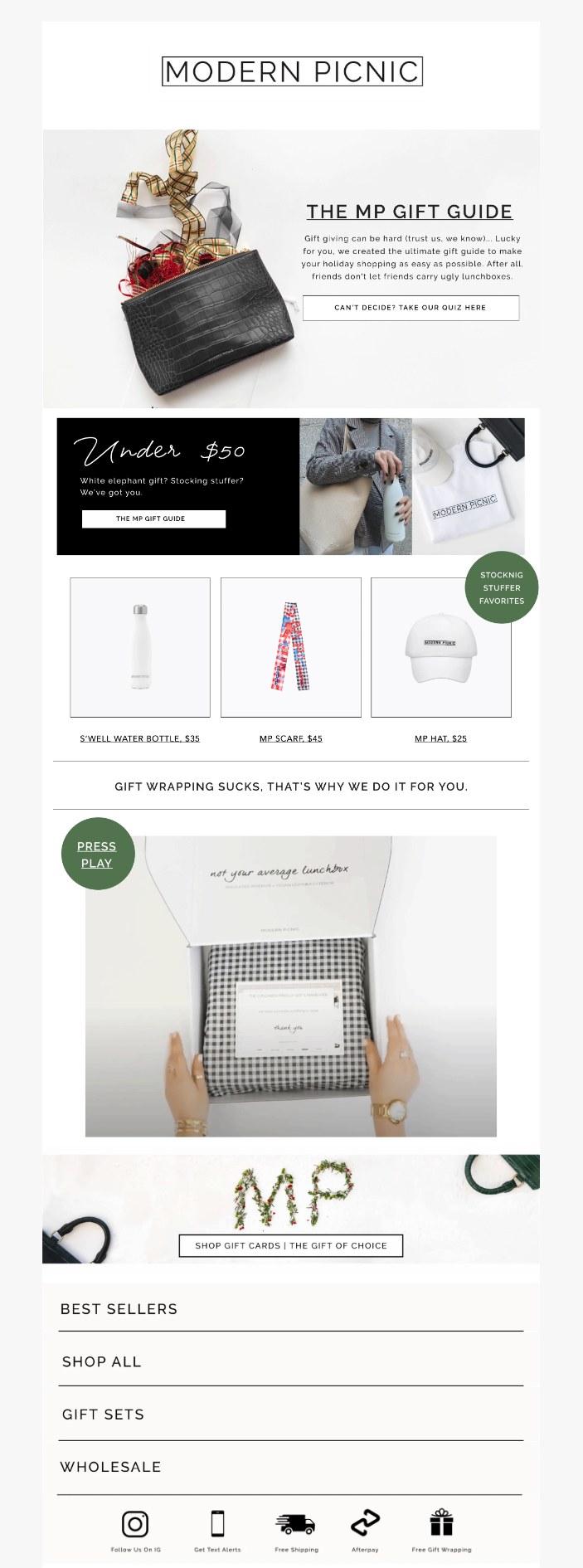
Modern Picnic’s email with a gift guide a week before Black Friday. Source: Milled
Make your BFCM emails the most profitable ever
The weeks leading up to BFCM are go-time for your ecommerce shop. By taking the time to thoughtfully segment and prepare targeted campaigns, you can increase your open rates, improve deliverability, and ultimately increase revenue.
Shopify’s mighty segmentation features let you automate and streamline this process with custom attributes, locations, purchase habits, and email behaviors. This way, you can connect with high-value customers, reward repeat buyers, and convert abandoned checkouts.
Start now. It will be worth it.
Black Friday consumer segmentation FAQ
What is the marketing strategy of Black Friday?
Black Friday is the busiest time for online shoppers in the entire year, so it’s worth investing in your Black Friday marketing strategy. This can include limited promotions for high-value (VIP) customers, influencer marketing campaigns, social media ads, and product recommendations based on previous purchases and browsing sessions.
When should I start marketing for Black Friday?
You should start warming up your email audience to your BCFM deals around a week before Cyber Weekend. On social media, you can start even earlier to build anticipation and grow your email list. For this to be successful, start planning your Black Friday Cyber Monday marketing activities in the months leading up to November.
How do you retain customers after Black Friday?
To keep your new customers coming back even after Cyber Weekend, ensure a fantastic customer experience. That includes a smooth checkout process, timely emails like transactional, shipping, and feedback-asking emails, as well as a simple and transparent return process. Segment your new customers based on what they shopped for, so you can send relevant emails and product recommendations to them in the long run.
Read More
- An Omni-Channel Commerce Solution: The What, Why, and How of Retail’s Future
- How 3 Brands Scaled Their Ecommerce Subscription Model 100-350%
- Multi-Channel Order Management for Multi-Million Dollar Growth
- Shipping and Supply Chain Best Practices from UPS, Deloitte, and 6 River Systems
- Best Holiday Campaigns with Advertising Examples from 335 Years of Retail
- What to Do After You've Lost a Loyal Customer
- How to Avoid the Hidden Cost of Black Friday, Cyber Monday Sales and Increase Customer Lifetime Value through Personalized Email
- Ecommerce Chatbots: 22 Ways to Increase Sales, Conversions & Retention
- How to Use a What-if Analysis to Measure the Effects of Your Decisions






